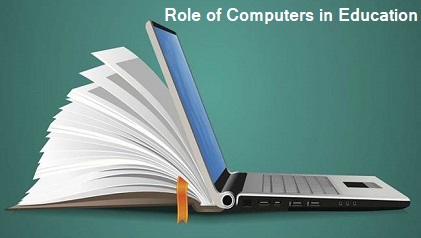Role of Computers in Education
Computers have revolutionized in education sector too. The concept of the conventional classrooms is changing. The old classroom has given way to a modern classroom in which computers are used for enhancing ideas and giving a more real-life and visually oriented education. An important factor in using computers is the intellectual advantage resulting from their use in the conventional classroom everything was taught on the black board. Only verbal explanation was possible. This method had a lot of limitations in conveying ideas. CBT is an acronym for Computer Based Training. This uses multimedia and classroom projectors containing training material beneficial for students and teachers on various subjects.
With the Internet revolution, education has also moved on the World Web platform. Many universities are using the web for distance education and distribution of study materials and syllabi to students. Following are some of the key advantages in using computers in education.
♦ Interactive classroom
♦ Conduct online classes
♦ Can do science projects using software
♦ Can search and study about interesting subjects from Internet
♦ Webinars
♦ Softwares are available that demonstrate topics with solved examples in science and Mathematics
Education is now considered as a continuous learning process. Age is not a criterion in modern education. As knowledge can become obsolete after a few years, education must focus on continuous learning. In educational institutions computers are used as teaching aids, information resource and computing and research tool.
When computer is utilized as an education aid it is called as 'Computer-Assisted Instruction' (CAI). The subject material is displayed on the Monitor. The computer also asks questions to test the students. When a student gives correct answer, the computer gives some comments to indicate that the answer is correct. If the answer is not correct, the computer gives some error signal. The CAI programs can be prepared in a variety of modes, such as tutorial, discovery, problem solving, modeling, and drill and practice mode.
In tutorial mode, the computer presents new ideas followed by test questions. In discovery mode, the computer presents information and asks students to draw conclusions. In problem solving mode, computer allows students to apply some concepts in solving a problem. In modeling mode, a process or a system is presented mathematically to make its analysis. Students are allowed to change variables to see their effects. In drill and practice mode, it is assumed that the skill in question is known but repetition is essential to have command over the subject. The interactive feature of the computer makes computer-aided teaching attractive. Computers can repeat the presentation of the material as many times as desired. This helps students make certain concepts clearer if they are not clear in earlier attempts.
Other attractive features of computers are their multimedia capabilities - particularly colour graphics ability. Pictures can move, rotate, computer can speak; all these features attract students. Graphics help students to see three-dimensional figures and view from different angles. Figures can be enlarged or reduced.
Computers are widely used for computation, design and research. The word processing package is used for preparing text, typing thesis, office and administrative work, preparation of test questions etc. Data processing capability of computers are used by students, teachers and research scholars to analyze, manipulate and process data. Information stored in databases serves as a learning resource for students. Question banks may be prepared and stored in the computer.
Education is now combined with entertainment and is often called ‘Edutainment’. Edutainment is broadly defined as software, electronic books and interactive games which have an educational component. This new form of education through computers is more effective than the conventional class room learning. The student can decide when and where he or she wants to listen or participate. Students both residential and non-residential can attend lectures broadcast to their homes or work places and get reference materials from distant locations using computers. Local and wide area networks will enable universities to integrate many aspects of education. Computers have revolutionized the teaching profession. Teachers use computers to record marks, calculate averages, record attendance and access the progression of student in online programs and assessments.
Computers in Examinations
Computers are widely used for processing examination results. It is also used by Universities to set question papers for different subjects from a question bank stored in the database of computers. Questions can be selected at random for different subjects. After evaluation, the marks are also entered into the database of students registered. The computer can decide classes, distinctions, ranks etc. of the students and prepare and print the mark lists.
Computers are also widely used in competitive examinations, entrance examinations etc. which use objective type questions with limited number of choices of answers for each question. Special types of answer sheets are used. It contains question number followed by a number of bubbles representing the choice of answers. A candidate has to shade a bubble of his choice. Optical mark readers are used to read the answers represented by shaded bubbles and the data are first stored in the computer. Data are then processed by a computer program to prepare the rank list. The whole process of evaluation takes only a few hours though thousands of candidates’ answers are to be evaluated.

